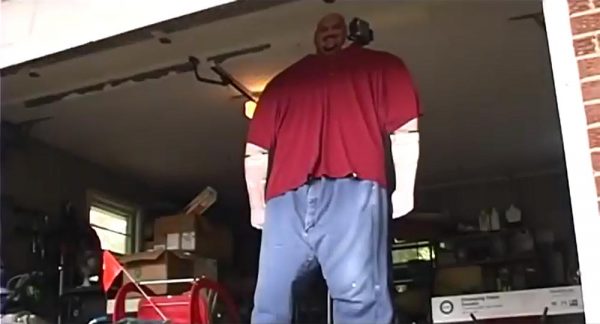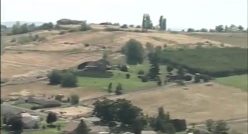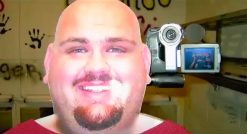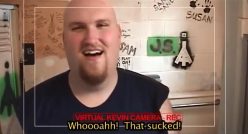For me to ever have created MicroFilmmaker Magazine in 2005, two key elements had to occur in my life. The first was that, in 2003, I make a narrative first film called Commissioned, which revolved around the world of commissioned computer sales, that broke all the cardinal rules of Indie filmmaking and suffered because of it. (The audio ended up being so bad that the film couldn’t be salvaged, even after a year of redubbing, due to the fact that two actors never returned to loop their work.)
 After learning how to solve all the problems of that first film after the fact (including: don’t star in your own debut film and audio is far more important than visuals), my new friendship with the brilliant audio minds at Oakwood Recording Studios would challenge us to create an extremely ambitious documentary that was way ahead of its time. It would address questions of co-location, virtual community, societal disconnect, reality television, overcoming disabilities, and crowd funding—all before Facebook had taken over the internet, Facetime had taken over video conferencing, reality television had taken over TV, or Kickstarter had become the crowdfunding juggernaut it is today.
After learning how to solve all the problems of that first film after the fact (including: don’t star in your own debut film and audio is far more important than visuals), my new friendship with the brilliant audio minds at Oakwood Recording Studios would challenge us to create an extremely ambitious documentary that was way ahead of its time. It would address questions of co-location, virtual community, societal disconnect, reality television, overcoming disabilities, and crowd funding—all before Facebook had taken over the internet, Facetime had taken over video conferencing, reality television had taken over TV, or Kickstarter had become the crowdfunding juggernaut it is today.
So what happened to it? And why haven’t you been able to see it before now? Read on and find out!
The Origin Story
When Kevin, my best friend from Washington State, came to live in Lexington, Kentucky, he fell in love with the Bluegrass region of the Midwest. The people, the social customs, the scenery, the animals, and even the summery humidity—all were like a part of Americana that he’d been denied his whole life and finally got to experience.
However, 18 months later, members of his extended family grew ill back in Yakima, the city in Washington State where he was from. (Sometimes called the “Mos Eisley” of Washington, Yakima is one of the largest growers of apples for the worldwide market—with a seedy underbelly that smuggles a lot of drugs in and out of the city, since apples rival coffee for confusing drug dogs.) He decided that he was needed most with his family, and he moved back to Yakima. As soon as he did so, he was filled with a deep sadness and regret, which grew even stronger after his sick family members passed on, yet he no longer had the financial means to come back.
If only he could get a job lined up ahead of time with someone here in Lexington, maybe he could afford to come back. Remember, that this is during the dark ages of the internet, where entire parts of the country (including Kentucky) felt like the internet was a fad that would be gone tomorrow, with many local businesses not having websites—much less a system for interviewing people from other parts of the country for jobs. (Of course you could have a phone conversation, but hires over just a phone conversation have always been unbelievably rare, because you can’t see a person’s body language or get a feel for their mannerisms or look them in the eye. In Kentucky, especially, that last part is worth its weight in gold!)
Kevin’s always been the sort of gregarious person that, if you meet him once, you’re friends for life, so I felt certain that if we could give people the impression of physically meeting Kevin, he would be all set. (A huge teddybear of a guy, his physical size combined with his protective nature, makes people feel like they have nothing to fear from him, yet that he’ll keep them safe.)
Building A “Better” Kevin
In the pre-Facetime world of 2004, we realized that if we were going to let people feel like they’d “met” Kevin, we’d need to BUILD a Kevin they actually could meet.
Starting with hundreds of high rez images printed at a local walmart, we pieced together his overall body on hard board and then cut it out. With the help of an engineer friend, we fitted hinged joints to the knees and elbows of his flat (but life-size) body, and attached him to a mobile cart. Then we dressed him in actual clothes and rigged a cell phone to a splitter that went to to a speaker (so the person talking to him could hear his voice) and a Sennheiser Shotgun Mic in a shockmount (so he could hear the people he was talking to).
Always fascinated by psychology (and a filmmaker at heart), I realized that this entire journey needed to be documented and, in that moment, the documentary known as The Virtual Kevin Project was born.
We mounted a consumer level Sony DV Camcorder to his shoulder, so that we could record see what “Virtual Kevin” was seeing (even though Kevin had no way to actually see the feed in the aforementioned dark ages of 2004). This now required all of our audio to go through a mobile Samson mixer and into a mini-plug in the camcorder. (Fortunately, John Howard at Oakwood Recording Studios was great with making specialty cables and was willing to put his amazing genius to a project so crazy it shouldn’t have ever been possible. Which was especially useful, because this was also the time before anything you can think of was easily purchasable at Amazon, much less the advent of Prime.)
Whenever I could borrow a teacher friend’s Canon XL1, we would get establishing footage of the different places we’d take Virtual Kevin.
Now that this was a social experiment and documentary, as well as a way to try to get Kevin a job out here, we decided to expand the scope of the film so we could ask: What makes a person a person?
Could Virtual Kevin “walk” (or, more accurately, “be pushed by a silent tech/puppeteer”) walk down the street and talk with people? Would the members of the tiny town of Wilmore see him as part of their community if they did so? On top of going to a job interview, could Virtual Kevin go on a date?
The free flowing, existential nature of these questions would lead to one of the exciting films I’ve been a part of, yet also one of the hardest to describe. (In fact, it was so hard to describe, that my long time producer, Kari Ann Morgan, actually couldn’t wrap her head around the project and opted not to be involved, even though she was very supportive of it. This would later teach me the importance of being able to boil down a film concept to its smallest denominators so potential collaborators can connect with it and get invested in it!)
Feeling like circus barkers (and over-protective parents), we would prep Kevin back in Washington State about who he would be meeting (having to be his eyes) while we moved Virtual Kevin out into the world to see what we would uncover.
The Problems
Despite the general favorable response to Virtual Kevin as a person, the challenges he presented as a film were considerable. Making sure we kept audio clean enough that it would be usable for the film was extremely difficult and made us realize we would still need to use subtitles.
Further, I realized we needed footage of Yakima and of Kevin for people to be able to buy into what we were doing, so I and my audio technician had to fly out to Washington for a week to get as much footage as we could, taking the time to interview people who knew Kevin and were from his community there. (This was especially tough because I was going through an extended time of unemployment, after the computer sales firm I had worked at had shut down.)
After having directed, starred in, and edited my first film, I wanted to put as much separation as possible in my next film. Focusing on someone else as protagonist, while still being the director, I approached my brother-in-law, Justin, to be the editor. About to go down the intense filmmaking road at Full Sail in Orlando, Florida, he welcomed the chance to work on editing a feature so that he was a little more prepared for classes. He came to live with us for a month to do the edit of the film.
As the edit was assembled, it became more and more apparent that a little more thinking of what we wanted the documentary to focus on would’ve been helpful early on, as we now had hundreds of hours of footage from four different cameras to cull to try to make a cohesive story. (Remember that part I mentioned earlier about breaking things down in small denominators? That’s where it was really being driven home how important that should be.)
At the same time, we were struggling to find bands that would be a good fit for our soundtrack and, after finding one gentleman that we loved, discovered he wouldn’t let us use the music unless he got an unlimited share of the film. As there was no way we were agreeing to that, we had to scramble to find music elsewhere. (Oh, what my past self would’ve given to have had access to Jamendo and the modern creative commons community then!)
When it came to how we should end the film, we had trouble discovering what the ending should be. We’d initially thought that Kevin would’ve found a job here and we could conclude with how he was now settling in, but, while people treated the work good-naturedly as a novelty, no actual jobs had shaken out of our work. As such, we decided to appeal to the audience and see if they wanted to help Kevin get out here—like a choose your own adventure story that your finances could help write. (Again, there was no such thing as IndieGogo or Kickstarter in those days, so we were seriously reaching—but I hoped the film might get into Sundance and then gain enough viewers to start some sort of grass roots funding campaign for him.)
Justin did a great initial edit of the film but, while we liked all the work he’d done on it, I realized that the director needed to come up with a more refined vision of it. As I was working on that, however, disaster struck.
We had put the film files on two separate hard drives, but, due to the fact that I didn’t really understand redundant backups and was manually doing it with two suboptimal drives, both hard drives died within 24 hours of each other, before more copies could be made. (Long time readers of MFM know that we’ve looked at many backup solutions over the years PRECISELY because of this horror story.)
We had only one copy of the film on DVD and, due to a glitch with how it was burned, I couldn’t make any more copies of the DVD. With no way to send out copies of the film and no time (or heart) to reassemble thousands of man hours of work, the film lived in a stack of DVDs for 12 years—not unlike the Ark of the Covenant at the end of Raiders of the Lost Ark.
The Film
After 12 years, I ran across the Virtual Kevin DVD and decided to run it through Handbrake. To my joy, I found that this OpenSource software could digitize the film so I could upload it to YouTube.
With no further ado, here is The Virtual Kevin Project—an extremely ambitious attempt to figure out the future of technology, community, and society.
Epilogue
While Kevin never did get moved out to Kentucky, he did meet a Southern girl in Yakima and is happily settling down with her. The completely different failures in each of my first two films inspired me to start MicroFilmmaker Magazine a year later, because I now knew how to NOT make those mistakes and wanted to pass that information on to other filmmakers. I wanted to empower storytellers around the world—because storytellers have the greatest chance to change the world for the better!
In so doing, I’ve had the chance to share concepts of microbudget filmmaking around, not just the United States, but the world, with filmmakers contributing or submitting films from China, Iceland, Australia, France, UK, Germany, Brazil, Canada, and many other ports of call. (And numerous things have been developed to simplify
The questions that we pondered about “what is community?”, however, still are waiting to be answered, as we discover more and more problems with local disconnect in favor of outside interaction that has no accountability. Personal isolation has been linked to some of the most violent crimes in our world’s history and the question of whether this can be prevented in the largely hidden sphere of the internet, Facetime, and Facebook still needs to be answered. (There is no question that stalking has gone up tremendously in the wake of Facebook, which presents itself as social interaction, but often leads to studying others from a distance as though they are playthings.)
While the current “Pokemon GO” craze may seem to argue against our ability to work together as a community online, as people ignore real people and even their own safety to hunt down virtual creatures with their phones, it’s also inspired many people to become more active and even take their families out to hunt pokemon, providing outings they might never have done. (The technology may also provide other ways for new stories to be told with similar “incentives” to get outdoors.)
While these things can be used for activities for local communities, the question remains: can we actually have true community from a distance? Kickstarter and the more directly connected Patreon speak to the fact that we can share resources to help new creations originate, as does Amanda Palmer and her interaction with fans through social media. Meanwhile, projects like Joseph-Gordon Levitt’s creative community, HitRecord, offer inspiring new evidence that we may indeed be able to come close to a true creative community not separated by distance. (Check out the video at the end of this article to get a feel for HitRecord’s work.)
If you’re a filmmaker or content creator who’s delving into the world of long distance creation, or defining community, or figuring out how we’re all interconnected, drop us a line, as I’d love to feature articles on your work in the future!



















